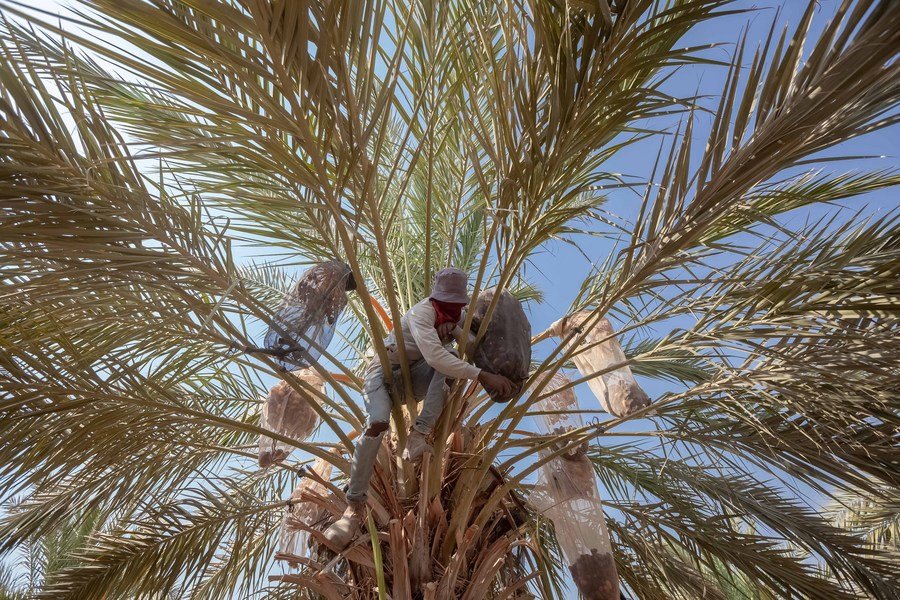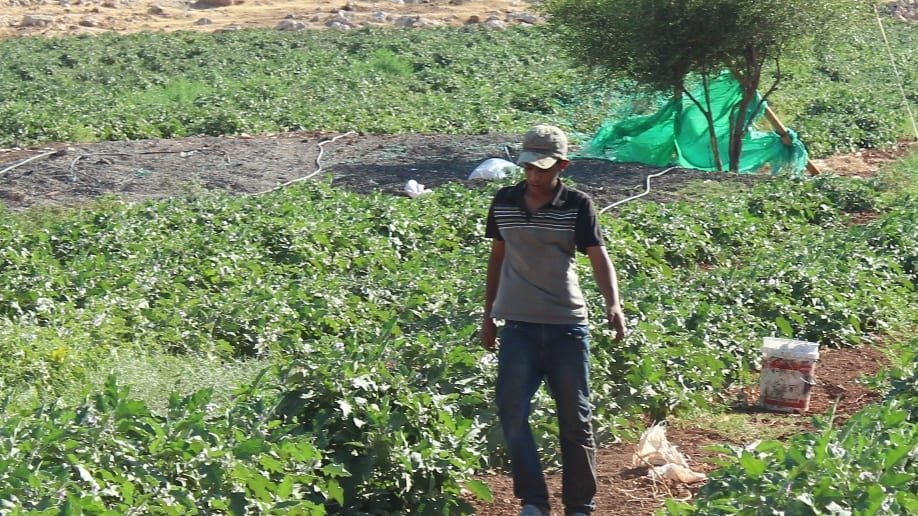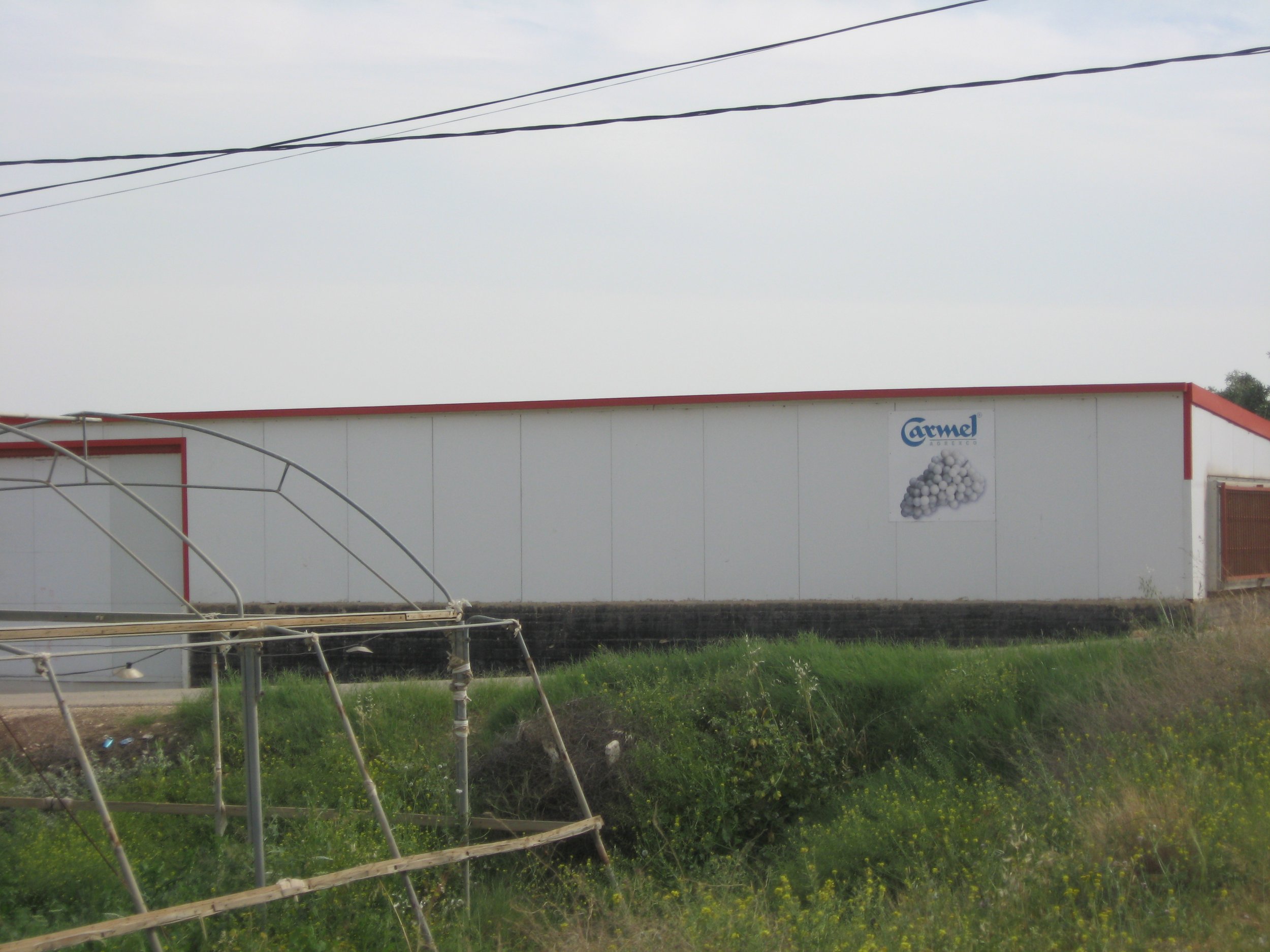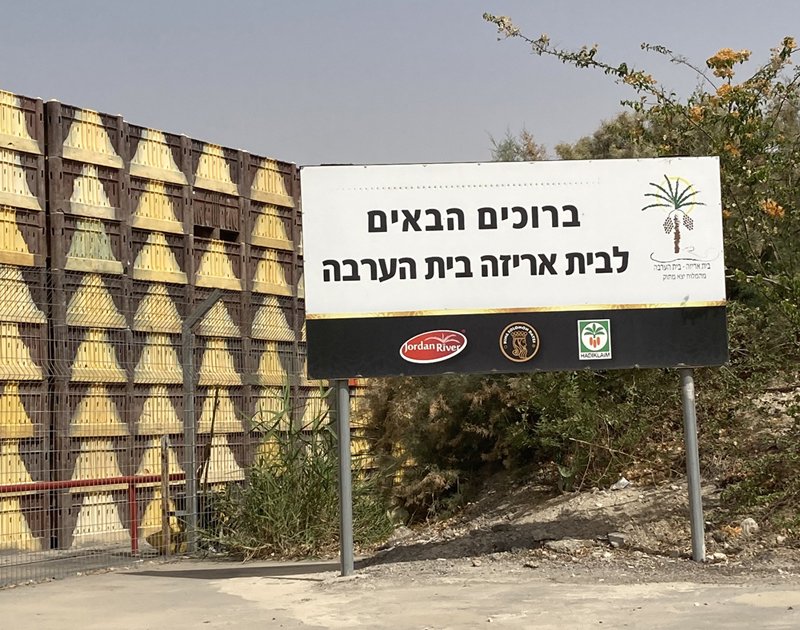Fruit Basket
Agriculture group, Yonghun Kim and Yuzhang Su focused on the analysis of Palestinians facing agricultural and environmental problems in Jericho and the Jordan Valley region, underscoring Israel’s policies and the impact of settlements on the West Bank. Historically, the Jericho region was known for its agriculture, and a variety of produce was harvested, especially bananas, which were the main crop in this region, and citrus fruits such as lemons and oranges. However, it has now been converted to the majority of date palm cultivation, except for a few banana plantations. Palestinian farmers in the Jericho region have shifted their farming methods because of challenges caused by soil salinization, water resource reduction, and several other factors. And now, their date palm farming practices face a significant challenge: extensive water controls exercised by Israeli authorities.
Shifting Agriculture Practice
Since ancient times Jericho area has been known for its rich and fertile land, maintaining the reputation of agriculture as the number of cultivated lands increased. In particular, Jericho is an agricultural city and is considered a Palestinian fruit and vegetable basket. The city’s high humidity and temperature are well known for producing bananas and various fruits such as dates, and citrus by creating soil suitable for growing various crops. In the 1960s, Jericho and surrounding areas were famous for their production of lemons, oranges, and bananas. Jericho Agricultural Land Drawing
In Jericho City, more than half of the area is arable, and vegetables, citrus, fruits, grapes, dates, and bananas are grown in this area. Agricultural production in Jericho relies mainly on spring water, and city residents grow citrus fruits, bananas, and dates in this way, but suffer mainly from obstacles to a lack of water resources. And, because of decades of building deeper wells to feed Israeli settlements in the West Bank near Jordan Valley, the spring water began to dry up each year.
Jericho Agricultural Land Use Drawing
This is a detailed map drawing of the total agricultural possible areas of the Jericho region.
Green: Date palm farm
Yellow: Banana farm
Red: Crops and vegetation
Purple: Greenhouse for citrus and fruit
Blue: Olive farm
Al-Auja Land Use Drawing
Figure 7) Al -auja Banana Plantation
In the past, banana cultivation was in full swing in the Jordan Valley and Al-Auja regions of Jericho Governorate, but today few farmers are found to grow bananas. According to a statement from the Palestinian Ministry of Agriculture, the decline in banana cultivation in Jericho is primarily linked to an increase in soil salinity. Farming bananas requires a lot of water, and Israel’s occupation policy to control most spring water in Jericho and the Jordan Valley has reduced the amount of water allocated to banana cultivation and increased salinity in the well, making them unsuitable for planting.
As the soil became more and more salty, Palestinian farmers began to grow date palms instead of bananas in the Jericho region and Jordan Valley. Date palm survives in saline soil in hot climates and requires little irrigation water compared to other crops such as bananas and oranges. Medjoul dates have the advantage of being able to grow only in very dry and hot conditions and withstand high levels of salinity. In addition, the date palm has the lowest labour intensity and the most economical material and operating costs.
The date palm sector is now considered one of the pillars of Palestine’s agricultural economy. According to the Preliminary Results of the Agricultural Census in Palestine 2021, the largest number of date palm trees are currently grown in the Jericho and Jordan Valley area of the West Bank, with 27806 Dunum.
However, some of the farms are distributed in Area C, which is under complete military control by Israel, and the lack of water supply due to measures to prevent excavations of underground water wells in Israel is currently the biggest problem facing date palm plantations.
Figure 8) Palestinian harvest dates
Jericho Governorate and Area C Drawing
“It is difficult to farm anything when you are under occupation. The last option for Palestinian farms is dates, but even now that is become more complicated because of what Israel is doing to us.”
— Zuhair AI Manasrah, Owner of Nakheel Palestine, 2013
Drawing Plan of Jericho Wastewater Treatment Plant
Efforts to Address the Water Crisis
Before 2014, Palestinian sewage treatment technology was limited due to restrictions on water supply and control of land by Israel. As the lowest city on earth, it was difficult for Jericho to obtain domestic water from outside the city. The underground water resources in Jericho were polluted by domestic water. It leads to the water crisis of Palestinian agriculture and reduces the quality of domestic water. As a result, it expanded human index inequality between Israeli settlers and Palestinians. To support a two-state solution for Palestine and Israel, the government of Japan proposed the "Corridor for Peace and Prosperity" as a mid-long-term initiative toward co-existence and co-prosperity between Israel and Palestine.Section Drawing of Jericho Wastewater Treatment Plant
Technical cooperation and financial assistance for infrastructure were provided by the Japan International Cooperation Agency to construct the Jericho Agro-Industrial Park. The Jericho Wastewater Collection, Treatment System and Reuse Project is one of the most important parts of 2014. The wastewater network was covering the refugee camp, the project was expected to improve the living environment of the refugees. In 2016, with the help of the United States Agency for International Development, the network of pipelines for wastewater treatment would be expanded. It was expected that 10,000 new residents to the network. The project will be a great help to the farmers in the city of Jericho and the Jordan Valley, especially palm farmers, as it will increase their irrigation resources, which is the biggest problem plaguing this sector.
Testimony
-
We were constantly suffering from the flooding of cesspits. But after connecting the house to the sewer network, we got rid of unpleasant odors. Sewage project provided us with a benefit and we were not harmed by it at all.
Laleh amelsa Desla, Palestinian Old Woman
-
At the beginning of the visit, we expected to notice unpleasant odors inside the wastewater treatment plant. On the contrary, we did not notice any unpleasant odors. We visited the irrigation tank and noticed the presence of fish and fed them.
Ahiza-Duouba Tang, Palestinian Student
-
I got an amount of water that wasn't at all I want. But, that is what I managed to get. Because it's not only about me, there are a lot of palm farmers in Jericho and all of the want to irrigate his trees. For us it depends on the capacity of the plant that saved us, we signed contracts with them to get water for our farms. Thank God, frankly, we were about to be bankrupted but the water of the plant is a gift from God.
Erazmdmk, Palestinian Palm Farmer
Plan Drawing of Israel Wastewater Treatment Plant
Israel’s Wastewater Treatment Plant
The Israeli wastewater treatment plant, owned by the Israeli company Mekorot Development and Enterprise, supports the date farms of two Israeli settlements around Jericho. One is Kalya, is situated south of Jericho, while the other one, Na’omi, is located north of Jericho. This wastewater treatment plant is located approximately 3km away from Jericho. However, it not only serves wastewater from the eastern part of Jerusalem but also caters to other smaller municipalities and communities. The total population equivalent of these areas is around 150,000. It is a project aimed at recovering the seasonal river Nahal Kidron from water pollution.
Screenshot, Rendered Footage of Kalya Reservoir
Screenshot, Rendered Footage of Na’omi Reservoir
Master plan of Israeli Sewage Treatment Plant
Underground Piping
Underground pipes with a total length of approximately 40 km will be installed from Jerusalem to the sewage treatment plant located near the Dead Sea. The rout also passes through the territory controlled by the Palestinian Authority, specifically Area A, and it was agreed upon by the Palestinian government. In the later plan, the system expands to the north part of the West Bank, supporting the date agriculture in different Israeli settlements along the Jordan River. However, even though the gravity pipe goes through Jericho, it has no contribution to dealing with the sewage in Jericho. In contrast, illegal Israeli settlement agriculture competes with agriculture in Jericho by irrigating date farms in Kalya and Na’omi.
Jordan River Map Drawing
Jordan River
More farmland needs to be nourished by the natural water source of the Jordan River. Restricted by the Israeli military-controlled area, known as Area C, Palestinians face significant challenges in farming on the riverbanks. The Above Map drawing shows the entire Jordan River by marking the border between countries, and the boundaries between agriculture land and non-agricultural land. As a new archive demonstrating how Israel’s inhumane water policies towards Palestine are affecting large areas of natural and agricultural landscapes.
Agriculture Land Analysis Between Jericho and Jordan
This analysis explores the contrast between the thriving farmland in Jordan on the eastern side of the river, which reflects a harmonious relationship between the country and the river, and the barren western side dominated by Israel’s military-controlled Area C and Jericho City. The struggle to expand Palestinian farmland is evident, particularly around Jericho City, where the date farm is situated along the boundary of Area C. However, smaller, scattered fields within cities lack the cohesion necessary for a sustainable agricultural system.
Figure 9) Palestinian children working in settlement farm
Israel Settlement and Exploited Labor
Israel established illegal settlements near the Jordan Valley and Jericho in the West Bank, and found date palm farms in each region. More than half of the West Bank’s agricultural land is located in Area C, controlled by Israel. Today, about 40 percent of Israeli date palm is grown in illegal settlements, and Israeli settlers exploit Palestinian workers at low wages to carry out hard date harvesting. Among these workers, small farm owners whose agriculture is no longer possible, adults and young Palestinian children. According to the Jericho Labor office, about 3,000 local residents work on settelment farms, surging to about 8,000 during the harvest season. Workers are exploited for long periods of time on high ladders, exposed to many dangers, but are not treated or compensated for injuries.
Israel Settlements located in Northern part of Jericho
Israel Settlements located in Southern part of Jericho
Located in the northern settlements of Jericho, Mevo’ot Yerikho, Na’omi, Tomer, Netiv HagDud, Gilgal, Fatsa’el, Yafit, and in the southern areas of Jericho, Vered Yeriho, Beit HaArava, and Kalya regions have exploited the Palestinian workforce at low wages and put young Palestinian children at risk.

“In the date season, I was required to climb a ladder to a height of two to three meters, or use a crane, to prune date palms and pick dates. The date trees have a lot of spikes, and once I cut myself and couldn’t work for a month. I wasn’t paid any compensations, because if I don’t work, I’m not paid. If I go to the doctor, I pay for it myself.”
— A 15-year-old Palestinian Child from Fasayil, Worked in the settlements of Tomer and Fatsa’el (2015)
Figure 20) Hadiklaim
Figure 21)Carmel Agrexco
Dates harvested from Israeli illegal Settlements’ Farm, package and ship under brands belonging to the Israeli agricultural cooperation, Hadiklaim and Carmel Agrexco. Both were accused of low-wage exploitation of Palestinian workers and children labor. The two operate large packaging stations, cooling facilities and date farms in the north and south of Jericho, where dates harvested and packaged using Palestinian labor exploited is exported to the United States and Europe.
“There’s more than one kind of pesticide; one is strong, another is weaker. I war gloves, and when I use the strong pesticide I also get a paper mask. Deathlon is one of them. You mix 30 liters of water and 100 centiliters of this. Basta is the other one. We mix the two of them for better effect, with water.”
— A 16-year-old Palestinian Child, Work in the greenhouse located at Tomer settlement (2015)
References
Figure 1) Follett, Chelsea. Centers of Progress, Pt. 1: Jericho (Agriculture). Human Progress, 2020, https://humanprogress.org/wp-content/uploads/2020/04/jerichonew-01-1.jpg.
Figure 2) Memory, Palestine Agricultural. Banana Plantations in Jericho 1930 AD. The Palestinian Information Center, 2017, https://www.facebook.com/Traditional.of.Palestinie/posts/1391861270905833/?locale=ar_AR.
Figure 3) Atwan, Rami. 2011, https://www.palestineremembered.com/GeoPoints/Jericho_525/Jericho-76330.webp.
Figure 4) Jericho Bananas Could Face Extinction. 2017, https://group194.net/english/article/54690.
Figure 5) Banana Rihawi Is Struggling to Survive. https://snd.ps/p/4736.
Figure 6) AI-Astal, Islam. Jericho Bananas Struggle with Settlement. 2023, https://nawa.ps/ar/post/49866/%D9%85%D9%88%D8%B2-%D8%A3%D8%B1%D9%8A%D8%AD%D8%A7-%D9%8A%D8%B5%D8%A7%D8%B1%D8%B9-%D8%A7%D9%84%D8%A7%D8%B3%D8%AA%D9%8A%D8%B7%D8%A7%D9%86.
Figure 7) Wolf, Kobi. Afyet’s Banana Seedlings Are A Rare Spot Of Green In The Arid Landscape. The Washington Post, 2020, https://www.washingtonpost.com/world/middle_east/west-bank-israel-water/2020/09/24/a607c854-f2d3-11ea-8025-5d3489768ac8_story.html.
Figure 8) CCTV. Palestinian Farmers Harvest Dates in the West Bank City of Jericho. Facebook, 2020, https://m.facebook.com/cctvcom/posts/palestinian-farmers-harvest-dates-in-the-west-bank-city-of-jericho-on-sept-8-202/10159069289294759/?locale=es_LA.
Figure 9) Elmuti, Dina. Palestinian Child Laborers Work off the Books in Israeli West Bank Settlements. DAILY BEAST, 2013, https://www.thedailybeast.com/palestinian-children-the-invisible-workers-of-israeli-settlements.
Figure 10) SHOALCOLLECTIVE. (2010a). Date palms near Gilgal settlement. Corporate Occupation. https://corporateoccupation.org/2010/04/18/netiv-hagdud-and-gilgal/
Figure 11) SHOALCOLLECTIVE. (2010b). Date palms near Gilgal settlement. Corporate Occupation. https://corporateoccupation.org/2010/04/18/netiv-hagdud-and-gilgal/
Figure 12) SHOALCOLLECTIVE. (2010c). Date palms near Gilgal settlement. Corporate Occupation. https://corporateoccupation.org/2010/04/18/netiv-hagdud-and-gilgal/
Figure 13) Corporate Watch Research Blogs. (2010a). TDP Export sign in Tomer. Corporate Occupation. https://corporateoccupation.wordpress.com/2010/04/13/corporations-in-tomer-settlement/
Figure 14) Corporate Watch Research Blogs. (2010b). Agrexco in Tomer. Corporate Occupation. https://corporateoccupation.wordpress.com/2010/04/13/corporations-in-tomer-settlement/
Figure 15) SHOALCOLLECTIVE. (2010c). Avniv’s Packing house in Netiv Hagdud/Gilgal Agricultural area. Corporate Occupation. https://corporateoccupation.org/2010/04/18/netiv-hagdud-and-gilgal/
Figure 16) Corporate Watch Research Blogs. (2010d). Agrexco in Tomer 3. Corporate Occupation. https://corporateoccupation.wordpress.com/2010/04/13/corporations-in-tomer-settlement/
Figure 17) Corporate Watch Research Blogs. (2010e). Nirav in Tomer. Corporate Occupation. https://corporateoccupation.wordpress.com/2010/04/13/corporations-in-tomer-settlement/
Figure 18) Hadiklaim - Israel Date Growers cooperative. (n.d.). WHO PROFITS RESEARCH CENTER. https://www.whoprofits.org/companies/company/4105
Figure 19) Corporate Watch Research Blogs. (2010f). Agrexco’s main packing bay in Tomer. Corporate Occupation. https://corporateoccupation.wordpress.com/2010/04/13/corporations-in-tomer-settlement/
Figure 20) Hadiklaim. (n.d.). Hadiklaim Logo. Hadiklaim. https://www.hadiklaim.com/
Figure 21) Agrexco, C. (n.d.). Carmel Agrexco Logo. Carmel Agrexco. http://www.agrexco.com/
British Pathe. OUT TAKES - CUTS FROM CP 601 - REEL 1 OF 2 - JERICHO (1966). 1966, https://www.britishpathe.com/asset/38061/.
Su, Kyle. JICA Sewage Treatment Plant, 11 Oct. 2023. Accessed 6 Dec. 2023.
Su, Kyle. Section drawing of JICA Sewage Treatment Plant, 11 Oct. 2023. Accessed 6 Dec. 2023.
Su, Kyle. Israeli Sewage Treatment Plant, 11 Oct. 2023. Accessed 6 Dec. 2023.
Su, Kyle. Wastewater transforming system mapping, 11 Oct. 2023. Accessed 6 Dec. 2023.
פרץדוד. “החל המסע להפוך את הנחל לפנינת ההיסטוריה שהוא.”
24 June 2023, news.walla.co.il/item/3369096. Accessed 5 Nov. 2023.
AI-Astal, Islam. “Jericho Bananas Struggle with Settlement.” FILASTINYAT, 2023, https://nawa.ps/ar/post/49866/%D9%85%D9%88%D8%B2-%D8%A3%D8%B1%D9%8A%D8%AD%D8%A7-%D9%8A%D8%B5%D8%A7%D8%B1%D8%B9-%D8%A7%D9%84%D8%A7%D8%B3%D8%AA%D9%8A%D8%B7%D8%A7%D9%86.
Greenwood, Phoebe. “Palestine’s Date Farmers Suffer Double Burden of Occupation and Indifference.” The Guardian, 2012, https://www.theguardian.com/global-development/2012/nov/07/palestine-date-farmers-occupation-indifference.
Hendrix, Steve. “The Famed ‘Jericho Banana’ Is Vanishing. Under Israeli Occupation, There’s Not Enough Water.” The Washington Post, 2020, https://www.washingtonpost.com/world/middle_east/west-bank-israel-water/2020/09/24/a607c854-f2d3-11ea-8025-5d3489768ac8_story.html.
Palestinian. 2014, https://www.hrw.org/report/2015/04/13/ripe-abuse/palestinian-child-labor-israeli-agricultural-settlements-west-bank#_ftnref96.
“Palm Cultivation in Palestine.” WAFA, https://info.wafa.ps/ar_page.aspx?id=8701. Accessed 6 Dec. 2023.
Trottier, Julie, et al. “The Political Role of Date Palm Trees in the Jordan Valley: The Transformation of Palestinian Land and Water Tenure in Agriculture Made Invisible by Epistemic Violence.” Environment and Planning E Nature and Space, vol. 3, no. 1, 2020, pp. 114–140, doi:10.1177/2514848619876546.
Van Esveld, Bill. Ripe for Abuse. Human Rights Watch, 2015.





































